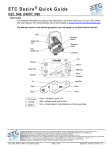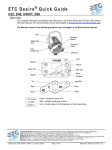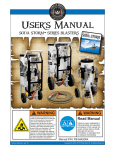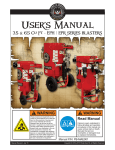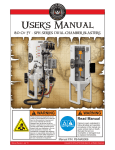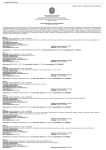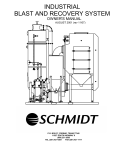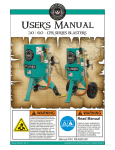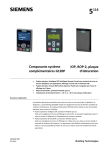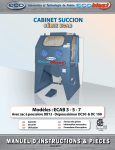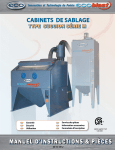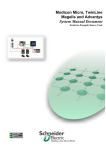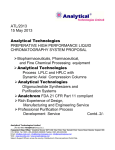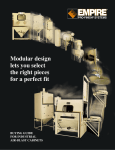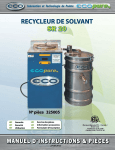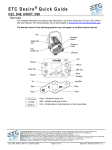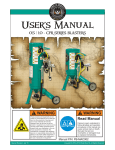Download Models 346-646 INSTRUCTION MANUAL & PARTS
Transcript
Innovation and Leading Technology PORTABLE PRESSURE BLASTER Models 346-646 With systems RC-176, RC-186 and Dual ( LG series ) INSTRUCTION MANUAL & PARTS 2013-04-03 346 & 646 Blasters - Instructions manual & parts 2013-04-03 1 Innovation and Leading Technology Ta b l e o f c o n t e n t s Page Definition of Terms Used In This Manual.............................................................................................. 3 WARNINGS................................................................................................................................................................. 4 SETTING UP THE BLASTER..................................................................................................................................... 5 Control system RC 176..................................................................................................................................... 6 Control system RC 186..................................................................................................................................... 7 Dual control system RC176/RC186............................................................................................................ 8 Before you blast................................................................................................................................................. 9 Blasting................................................................................................................................................................. 10 Blasting (cont’d).............................................................................................................................................. 11 Maintenance schedule................................................................................................................................. 12 Maintenance Procedures............................................................................................................................ 13 Troubleshooting............................................................................................................................................. 14 Troubleshooting (cont’d).......................................................................................................................... 15 Troubleshooting (end)................................................................................................................................. 16 RC-176 assembly - Exploded view.................................................................................................................. 17 RC-176 assembly - Parts list.............................................................................................................................. 18 AV-176 Air valve assembly - Exploded view............................................................................................ 19 Abrasive metering valve MMV-175 - Exploded view............................................................................ 20 RC-186 assembly - Exploded view.................................................................................................................. 21 RC-186 assembly - Parts list.............................................................................................................................. 22 Air valve AV-186 - Exploded view................................................................................................................... 23 Abrasive metering valve PMV-186 - Exploded view............................................................................. 24 RC176/RC186 assembly - Exploded view...................................................................................................... 25 RC176/RC186 assembly - Parts list.................................................................................................................. 26 RC176 & RC186 - Electrical boxes, exploded view.......................................................................................... 27 RC176 & RC186 - Electrical boxes, Parts list.................................................................................................... 28 RC176 & RCzx186 assembly - Electrical boxes, exploded view............................................................. 29 Control handle systems - Exploded view.............................................................................................. 30 Control handle systems - Parts list.......................................................................................................... 31 NOVA 2000 assembly - Exploded view.......................................................................................................... 32 NOVA 2000 assembly - Parts list...................................................................................................................... 33 RADEX Breathing airline filter - Exploded view.................................................................................. 34 RADEX Breathing airline filter - Parts list.............................................................................................. 35 WARRANTY INFORMATION................................................................................................................................. 36 2013-04-03 346 & 646 Blasters - Instructions manual & parts 2 Innovation and Leading Technology D e f i n i t i o n o f Te r m s U s e d I n T h i s M a n u a l Abrasive (also known as “media”): granular material used for blasting a surface. Blow down (also known as “depressurize”): to expulse air automatically or manually from a pressurized vessel. Control Handle: mandatory remote-control device used to start and stop the blaster. Depressurize (also known as “blow down”): to expulse air automatically or manually from a pressurized vessel. Pressure Hold System (also known as “manual blow-down system”): blasting system in which the pressure vessel stays pressurized when the control handle is released. Pressure Release System (also known as “automatic blow-down system”: blasting system in which the pressure vessel is automatically depressurized when the control handle is released. Pressure Vessel: enclosed section of the blaster filled with pressurized air and abrasive during blasting operations. Pressurize: to fill the pressure vessel with compressed air. Properly Trained Person: a person who has successfully passed a training course in sandblasting pertaining mainly to the safe operation of stationary or portable Abrasive Blasters with capacities ranging from 1.5 ft3 to 6.5 ft3 and who has read this entire manual and understands it Silica : hazardous substance found in many naturally occurring abrasives. NOTE: Abrasives containing silica must NEVER be used in any blasting situation. Even if respiratory protective equipment is used, the resulting dust can cause respiratory disease Safety Symbols The safety symbols below are designed to ensure the safety and protection of the Abrasive Blaster operator and of anyone else nearby. The explanations provided apply to sandblasting equipment. WARNING :This symbol indicates a potentially dangerous situation that could result in serious injury or death if the instructions related to the symbol are not carried out. Throughout the manual, this warning triangle will appear to denote instructions requiring special attention. 2013-04-03 DANGER : This symbol indicates a potentially dangerous situation that WILL result in serious injury or death if the instructions related to the symbol are not carried out. Throughout the manual, this warning triangle will appear to denote instructions requiring special attention. 346 & 646 Blasters - Instructions manual & parts 3 Innovation and Leading Technology Anyone who will be running the Abrasive Blaster or who will be nearby during its operation must receive appropriate training in the safe operation of the equipment and must be cautioned about the potential hazards. Besides being adequately trained, anyone who will be running the Abrasive Blaster or who will be nearby during its operation must read, understand and follow all the procedures explained in the user manual. For replacement manuals, please contact your distributor or go to www.ECO.com. Anyone who will be running the Abrasive Blaster or who will be nearby during its operation must use respiratory protection that meets OSHA and NIOSH standards for breathing apparatus and supplied air. Because they contain large amounts of accumulated energy, Pressurized Vessels can cause serious injury or death if safety procedures are ignored. Never perform maintenance on a pressurized Pressure Vessel or attempt to open it under any circumstances. Always depressurize the equipment and disconnect it properly from its air source before beginning maintenance. Never modify the Pressure Vessel or do grinding or welding on it under any circumstances. Otherwise, the ASME certification will be void. Damaged pressure vessels must NEVER be used. The appropriate Remote (Deadman) Control System must be used to operate the Abrasive Blaster. Abrasive Blasters must NEVER be used without Remote Controls. Bleeder-Type Control Handles must NEVER be used with RC-176 or RC-186 Series Blasters because they can create dangerous conditions where the blaster does not shut off when the handle is released. Anyone who will be running the Abrasive Blaster or who will be nearby during its operation must use the appropriate safety equipment as well as common sense to protect themselves. The required safety equipment includes, but is not limited to, hearing, eye, body and lung protection. Because of their weight, Abrasive Blasters and the objects being blasted can cause serious injury or death if they topple over. All OSHA and NIOSH safety requirements must be followed at all times. Only genuine ECO replacement parts must be used for maintenance on the Abrasive Blaster. The equipment must NEVER be altered under any circumstances. Using altered brand parts can create hazardous conditions and will void your warranty. Before using the Abrasive Blaster, inspect it and make sure it is in good working order. Malfunctioning or damaged equipment must NEVER be used. Only clean, cool, dry compressed air must be supplied to the Abrasive Blaster. Hazardous conditions can result if moisture or debris reaches the Remote Control System. Compressed air supplied to the Blaster must not exceed 150 psi. Using an air-line pressure regulator is strongly recommended. Abrasive Blasters must NEVER be used in locations that could be deemed potentially hazardous according to Article 500 of the National Electrical Code, NFPA 70. The Abrasive Blaster must NEVER be used in wet locations. Electrically controlled Abrasive Blasters must always be connected to a ground fault circuit interrupter (GFCI). 2013-04-03 346 & 646 Blasters - Instructions manual & parts 4 Innovation and Leading Technology how to S E T U P T H E B L A S T E R WARNING : The Operating Procedures described in this manual are intended to pr ovide basic information about the safe operation of the features of ECO RC-176/RC-186 Series Abrasive Blasters. The Abrasive Blaster should be operated only by persons who are fully trained in abrasive blasting. INSPECT THE PRESSURE VESSEL PURGE THE AIR SUPPLY HOSE When your Abrasive Blaster arrives, remove the Handway Assembly and check if any foreign objects have fallen in through the pop-up opening. If so, remove them all, and then reinstall the Handway Assembly. Before the Air Supply Hose is connected to the Abrasive Blaster, the hose must be purged of any moisture or debris. If there is standing water or moisture in the air line, the Abrasive Blaster will not perform optimally. Air supplied to the Abrasive Blaster must be cool, dry and clean. DANGER : Maintenance must NEVER be done on the Abrasive Blaster nor should anyone try to open it while it is pressurized. Otherwise, serious injury or death will result from the violent expulsion of compressed air and propelled objects. RE-TIGHTEN the HANDWAY ASSEMBLY Once you have pressurized the Abrasive Blaster for the first time, tighten the nut on the Handway Assembly. Also, whenever the Handway Assembly is removed for maintenance, you must tighten the nut again, prior to and following the next pressurization. DANGER : Maintenance must NEVER be done on the Abrasive Blaster nor should anyone try to open it while it is pressurized. Serious injury or death will result from the violent expulsion of compressed air and propelled objects. 2013-04-03 ATTACH THE REMOTE CONTROL HANDLE Using hose clamps or heavy wire ties, fasten the Remote Control Handle to the Blast Hose near the Nozzle. Next, form a loop of Twinline/ Control Cord where the first 6 inches of cord curve away from the Blast Hose, then the next 6 inches run parallel to the Blast Hose, and then the last 6 inches curve back to join the Blast Hose. At the location where the loop ends, fasten the Twinline/Control Cord to the Blast Hose by wrapping duct tape twice around the Twinline/Control Cord and then around the Blast Hose to form a strain-relief attachment. Do this only on the first connection near the Control Handle. Fasten the rest of the Twinline/ Control Cord to the blast hose by wrapping duct tape around the cord and the hose, every 3 feet, beginning at the Nozzle end of the Blast Hose. 346 & 646 Blasters - Instructions manual & parts 5 Innovation and Leading Technology R C 176 C o n t r o l s y s t e m How it works IMPORTANT : A PRESSURE REGULATOR SHOULD BE INSTALLED ON THE AIRLINE FROM AIR COMPRESSOR When the main air-line ball valve is ON, air is supplied to the AV-176 Combination Air Intake and Exhaust Valve, which is usually closed. When the Remote Control Handle on the dual air line is depressed, the AV-176 Combination Valve will be activated, so the air can flow in. This forces the Plunger Pop-up Valve to seal the filling port and close the exhaust section of the Combination Valve at the same time, thus pressurizing the Pressure Vessel. When the Control Handle is released, blasting will stop and the Pressure Vessel will automatically depressurize. When you have finished blasting, always be sure to close the main inlet air-line ball valve. 2013-04-03 346 & 646 Blasters - Instructions manual & parts 6 Innovation and Leading Technology RC 186 Control system How it works AV186 6 IMPORTANT : A PRESSURE REGULATOR SHOULD BE ON THE AIR LINE FROM THE AIR COMPRESSOR Make sure the main air-line ball valve is turned on. The Vessel will be pressurized, so the air can flow to the AV186 Air Valve. To begin blasting, depress the Remote Control Handle on the Blasting Hose near the Nozzle end. The Air Valve and the PMV186 Abrasive Metering Valve will then open, and blasting will begin. To stop blasting, release the Remote Control Handle. The Air Valve and the Abrasive Metering Valve will then close to interrupt the blasting stream; however, the Pressure Vessel will stay pressurized. When you have finished blasting or when you need to refill the Pressure Vessel with abrasive, depressurize the Vessel. To do so, first make sure the Control Handle is released. Next, close the main inlet air-line ball valve, and then slowly turn the manual depressurizing ball valve. 2013-04-03 346 & 646 Blasters - Instructions manual & parts 7 Innovation and Leading Technology R C 176 / R C 1 8 6 D u a l c o n t r o l s y s t e m How it works AV186 6 The air line feeds air to an AV-176 Combination Air Intake and Exhaust Valve, which is usually closed. Turning the Vessel Pressurizing Switch to ON activates the AV-176 Combination Valve. The Exhaust Valve part of the valve seals the Vessel as air pushes the Plunger up to seal the filling port of the Vessel, which will then become pressurized. Once pressurized, the Vessel is ready for blasting. Before blasting begins, close all the doors in the blasting room equipped with a safety door switch. Blasting can begin only once all the doors are closed. To begin, depress the Remote Control Handle on the Blasting Hose near the Nozzle end. The Air Valve and the PMV-186 Abrasive Metering Valve will then open, and blasting will begin. When you release the Remote Control Handle, the blasting will STOP. The Pressure Vessel will stay pressurized, ready to resume blasting when the Remote Control Handle is depressed again. When you have finished blasting or when you need to refill the Pressure Vessel with abrasive, release the Remote Control Handle. To depressurize the Pressure Vessel, switch the Vessel Depressurizing Switch to OFF. WARNING : THE PRESSURE VESSEL MUST NEVER BE LEFT PRESSURIZED WHEN NOT IN USE. The Pressure Vessel should be depressurized and the air-line supply turned OFF. 2013-04-03 346 & 646 Blasters - Instructions manual & parts 8 Innovation and Leading Technology Before Blasting PRE-BLASTing inspection Before each use of the Abrasive Blaster, check and make sure it is in safe working condition. Examine the seals, hoses and other components closely for wear or damage. Replace any damaged or worn component before you begin blasting. WARNING : An Abrasive Blaster must NEVER be used if any of its components are damaged or worn. Replace all damaged or worn parts before using the equipment. HOW TO ADD THE ABRASIVE Before you fill the Abrasive Blaster, be sure that the Inlet Valve is closed and that the Pressure Vessel is depressurized. Pour the abrasive into the top of the Abrasive Blaster. Allow it to flow around the Pop-up and into the Pressure Vessel. Make sure you neither overfill nor allow foreign materials to enter. To prevent foreign items from getting inside, the use of a screen is recommended. DANGER : NEVER reach inside while the Abrasive Blaster is being filled. The pop-up opening can close unexpectedly and cause serious injury or death. WARNING : Abrasives containing silica must NEVER be used with ECO Abrasive Blasters. WARNING : The Inlet Valve must NEVER be open while the Abrasive Blaster is being filled. Before you begin filling, always be sure to close it. WARNING : NEVER use electrically conductive abrasives when the Abrasive Blaster is being used with Electrical Remote Control Systems, unless the sealed strain relief connectors have been changed. WARNING : An Abrasive Blaster containing abrasive must NEVER be moved or transported. 2013-04-03 ABOUT THE REMOTE CONTROL SYSTEM An electrical or pneumatic Remote Control System (also referred to as “Deadman”) must always be used with an Abrasive Blaster to start and stop blasting. Electrical : On the Abrasive Blaster, the Remote Control Handle must be connected to the female twist-lock connector on the Abrasive Blaster. A 12 VDC power source (12-V battery or optional 120 VAC to 12 VDC converter) must be connected to the male twist-lock connector. Pneumatic : The Remote Control twin-line hose must be connected to the Abrasive Blaster using the threaded or quick-disconnect fittings that are supplied. Using pneumatic Remote Control Systems is not recommended with Blast Hoses exceeding 100 feet. WARNING : The Abrasive Blaster must NEVER be operated without a Remote Control System. DANGER : Caution must always be used around electrical sources to avoid electrical shock. Never operate electrically remote-controlled Abrasive Blasters in wet or other hazardous conditions. HOW TO CONNECT HOSES Before you connect hoses to the Abrasive Blaster, be sure the Inlet Valve is closed and the compressed air supply is off. Next, connect the hose from the compressed air supply to the inlet on the Abrasive Blaster and use safety clips to secure it. Using an air-line pressure regulator is strongly recommended. Connect the blast hose to the coupling on the Metering Valve at the base of the Abrasive Blaster. Use safety clips to secure it. WARNING : Safety devices, such as clips and whip checks (safety cables), must always be used to secure the hose. 346 & 646 Blasters - Instructions manual & parts 9 Innovation and Leading Technology Blasting HOW TO PRESSURIZING THE ABRASIVE BLASTER Before you pressurize the Abrasive Blaster, make sure that: All “BEFORE BLASTING” procedures have been carried out. The Inlet Valve is shut off. The Blow-down Valve is shut off (RC-186 systems only). The Remote Control Handle is released. Each hose connection is secure and reinforced with a safety clip. The Abrasive Blaster is set up in a safe location, on level ground, and everyone nearby has been informed of its presence. Anyone who will be near the Abrasive Blaster is wearing the required safety equipment. The only persons who will be near the Abrasive Blaster are those who have received the proper training and who have read the manual and understand it. Once these conditions are met, you can turn on the compressed air source and open the Inlet Valve on the Abrasive Blaster. At that point, the Abrasive Blaster will be ready for blasting. DANGER : Maintenance must NEVER be done on the Abrasive Blaster nor should anyone try to open it while it is pressurized. Otherwise, serious injury or death will result from the violent expulsion of compressed air and propelled objects. The compressed air supplied to the Abrasive Blaster should NEVER exceed 150 PSI (10.3 BAR). WARNING : Activating the Remote Control Handle can cause the Blast Hose to kick back. Prepare by bracing yourself. Blasters with MMV175 Metering Valves usually kick back erratically for a short while when they first start up. WARNING : All persons who will be in the vicinity of the blasting operation must be adequately trained, must have read and understood the manual and must be wearing the necessary safety equipment. 2013-04-03 HOW TO USE THE ABRASIVE BLASTER To prepare for blasting, pressurize the Abrasive Blaster. To begin the flow of abrasive and compressed air, push the safety flap down and squeeze the Remote Control Handle. To adjust the air-abrasive mixture, turn the handle on the Metering Valve. It will take a bit of time for the adjusted mixture to reach the Nozzle. The delay will vary according to the length of the Blast Hose. Before you make adjustments, stop the Abrasive Blaster by releasing the Remote Control Handle. After a short period, which will again depend on the length of the hose, the flow of compressed air and abrasive will come to a halt. On Pressure Release (RC-176) Abrasive Blasters, the Pressure Vessel automatically exhausts through the Blow-Down valve. This causes a burst of compressed air, which can project loose objects, debris or abrasive toward anyone in the area. Therefore, no one should be close to a Pressure Release (RC-176) Abrasive Blaster during blasting operations. DANGER : Respiratory disease can result from airborne particles generated by abrasive blasting. Anyone involved in the blasting operation or in the vicinity must wear the appropriate NIOSH/OSHAapproved breathing apparatus. Abrasives containing silica must NEVER be used. DANGER : Always stay clear of a Pressure Release (RC176) Abrasive Blaster while it is running. When the Remote Control Handle is released, compressed air will rush out suddenly and violently from the exhaust valve. You must wait until the Abrasive Blaster is depressurized before adjusting the Metering Valve. WARNING : Only persons who have been fully trained in abrasive blasting should run the Abrasive Blaster. This manual provides only basic information on the safe operation of the features of ECO RC-176/ RC-186 Series Abrasive Blasters.. WARNING : You must NEVER point the Blast Nozzle towards anyone, including yourself, or towards the Abrasive Blaster. WARNING : Make sure the Choke Valve is completely open during blasting to prevent damage to the equipment. 346 & 646 Blasters - Instructions manual & parts 10 Innovation and Leading Technology Blasting (end) HOW TO DRAIN THE MOISTURE SEPARATOR The Moisture Separator must be drained periodically during blasting. To do so, it is best to keep the Drain Valve slightly open. This way, air will continuously escape and force the moisture out. WARNING : The Abrasive Blaster must receive clean, cool, dry compressed air to run properly. Depending on the quality of the air being supplied, the Moisture Separator included with the Abrasive Blaster may not have the capacity to ensure this is the case. HOW TO SHUT DOWN THE ABRASIVE BLASTER When you have finished blasting, you must shut down the Abrasive Blaster. To do so, release the Remote Control Handle and then shut off the Inlet Valve. In the case of an RC-176 Pressure Release, the Abrasive Blaster will be depressurized by that time. HOW TO DISCONNECT THE AIR SUPPLY HOSE Even once you have depressurized the Abrasive Blaster and shut off the Inlet Valve, the Compressed Air Supply Hose may still contain pressure, which must be expelled before you disconnect the hose. To do so, shut off the compressed air at its source and open the Drain Valve on the Abrasive Blaster. Slowly open the Inlet Valve on the Abrasive Blaster. This will allow the compressed air stored in the Compressed Air Supply Hose to exit through the Drain Valve. Once the sound of air escaping through the Drain Valve has stopped, squeeze the Compressed Air Supply Hose and make sure there is no more compressed air left inside. Once this is done, you can disconnect it. DANGER : Compressed Air Supply Hoses must NEVER be disconnected until the “HOW TO DISCONNECT THE AIR SUPPLY HOSE” procedures have been carried out. Otherwise, the hose could blow off violently and injure or kill someone in the area. When using an RC-186 Pressure Hold, make sure that the pneumatic Control Handle is released. Next, shut off the Main Air Supply Valve and slowly open the Blow-Down Valve to let out the compressed air that is stored in the Abrasive Blaster. AV186 RC-176 Pressure Release System 2013-04-03 RC-186 Pressure Hold System 346 & 646 Blasters - Instructions manual & parts 11 Innovation and Leading Technology Maintenance Schedule WARNING : Only experienced, qualified persons should perform maintenance. The maintenance procedures and timetable below must be followed; otherwise, the equipment may perform poorly or fail. Furthermore, the equipment warranty will become void. DANGER : Maintenance must NEVER be done on the Abrasive Blaster nor should anyone try to open it while it is pressurized. Serious injury or death will result from the violent expulsion of compressed air and propelled objects. Inspections and Maintenance Frequency 1- Inspect personal protective equipment Every day 2- Inspect remote control handles and control hose/cord Every Day 3- Inspect blast hose, couplings & gaskets Every Day 4- Inspect blasting nozzle Every Day 5- Inspect air hose, couplings and gasket Every Day 6- Inspect & clean blow-down muffler (if equipped) Every Week 7- Inspect pop-up & pop-up gasket Every Months 8- Service metering valve Every 3 Months 9- Service combination valve (if equipped) Every 3 Months 10- Service control valve(s) (if equipped) Every 3 Months 2013-04-03 346 & 646 Blasters - Instructions manual & parts 12 Innovation and Leading Technology Maintenance Procedures 1. Inspect Personal Protective Equipment (PPE) Inspect all PPE to make sure that it fits and that it is in good working condition. Replace or repair PPE, or have it fitted, as needed. 2. Inspect Remote Control Handles and Control Hose/Cord Pneumatic Remote Control Systems : Inspect the Control Handle to be sure the Safety Flap/Lever Lock/Button is in good working condition. Check for damages, and replace or repair components as needed. Inspect the twin-line hoses and replace them if there are leaks, abrasions or soft spots. Electric Remote Control Systems : Inspect the Control Handle and make sure the Safety Flap/Lever Lock/Button is in good working condition. Check for damages, and replace or repair components as needed. Inspect the control cord and replace it if there are damaged plug ends or signs of abrasion, exposed wires or cracks 3. Inspect Blast Hose, Couplings & Gaskets Check the Blast Hose for leaks, abrasions and soft spots. Inspect the couplings for damage, leaks and wear. Check the coupling gaskets for leaks and wear. Replace all components as needed. Be sure safety clips and whip checks (safety cables) are used to secure Blast Hose connections. 4. Inspect Blasting Nozzle Check the Blasting Nozzle for wear, and measure the bore diameter. If the bore diameter is worn to the point of being 1/16 in. larger than its original diameter, replace the Blasting Nozzle. For instance, a #5 Nozzle (5/16 in. bore) needs to be replaced when the bore reaches 3/8 in. 5. Inspect Air Hose, Couplings & Gaskets Check the Air Hose for leaks, abrasions and soft spots. Check the couplings for damage, leaks and wear. Check the coupling gaskets for leaks and wear. Replace all components as needed. Be sure safety clips and whip checks (safety cables) are used to secure Air Hose connections. 6. Inspect & Clean Blow-down Muffler Remove the Blow-Down Muffler and turn it upside down. Tap it on a hard surface to free any debris that may be trapped inside. Replace the muffler if it is blocked and the obstruction cannot be cleared 7. Inspect Blow-down Hose Assembly Remove and inspect the Blow-Down Hose Assembly. Replace it if you find leaks or soft spots. 8. Inspect Pop-Up & Pop-Up Gasket Check the Pop-up and Pop-up Gasket for wear. Replace as needed 9. Service Metering Valve Disassemble and clean the Metering Valve. Check for worn components and make sure it is working properly. Replace any worn components. Lubricate the MMV-175 and PMV-186 valves with an anti-seize compound before reassembly. 10. Service Air Valve AV-186 Disassemble and clean the valve. Check for worn components and make sure it is working properly. Replace any worn components. Lubricate with an anti-seize compound before reassembly. 11. Service Combination Valve AV-176 Disassemble and clean the valve. Check for worn components and make sure it is working properly. Replace any worn components. Lubricate with an anti-seize compound before reassembly. 12. Service Control Valve(s) Disassemble and clean the valve(s). Check for worn components and make sure everything is working properly. Replace any worn components. Lubricate with an anti-seize compound before reassembly 2013-04-03 346 & 646 Blasters - Instructions manual & parts 13 Innovation and Leading Technology Tr o u b l e s h o o t i n g DANGER : The Abrasive Blaster must NEVER be opened while it is pressurized. Extreme caution is required when troubleshooting involves pressurizing the Abrasive Blaster. Only experienced, qualified persons should perform troubleshooting procedures. ABRASIVE NOT FLOWING DURING BLASTING (AIR ONLY) Possible Causes : 1. The Abrasive Blaster is empty. The abrasive cut-off function (if equipped) is engaged and is preventing the abrasive from flowing. 2. The Metering Valve is closed or not properly adjusted. If you suspect that a PMV-186 Metering Valve is not opening, conduct the following test : Shut off the Metering Valve completely by turning the knob clockwise until it stops. Next, turn it counterclockwise about 9 full turns. Then, depress the Control Handle and check if the knob is difficult to turn or does not turn at all If so, the Metering Valve is opening properly. 3. There is a blockage in the Metering Valve. To free the blockage from a PMV-186 Metering Valve, begin by turning the knob on the Metering Valve clockwise until it stops. Then, turn the knob counterclockwise 9 full turns so it is fully open. Depress the Control Handle and have a second qualified person close the choke valve for 2 seconds and then re-open it immediately. Minor obstructions, such as paint chips, a bit of wet abrasive or a piece of paper, will be forced through the Metering Valve and out the Nozzle. Turn the Metering Valve back to the required blast setting and check if the obstruction has been removed. If there is still a blockage, depressurize the Abrasive Blaster, remove the Pusher Line and the Metering Valve and check if there is a steady stream of abrasive. If so, allow the Abrasive Blaster to empty, and then reinstall the Metering Valve. It is advisable to use a screen to keep foreign objects from getting inside the Abrasive Blaster and causing a blockage. 4. There is wet abrasive in the Abrasive Blaster. The wet abrasive must be removed. To do so, depressurize the Abrasive Blaster, remove the Handway Assembly and scoop or vacuum out the wet abrasive. The Abrasive Blaster must always be used with dry abrasive and supplied with clean, cool, dry air to keep the abrasive dry. For outdoor operations, using a lid is recommended to prevent water from getting inside the Abrasive Blaster. ABRASIVE STREAM TOO HEAVY OR THROBBING during BLASTING Possible Causes : Note : When RC-176 systems first start up, they may throb for a while if there is an accumulation of abrasive in the blast hose from a previous operation. This is normal, and no corrective action is needed. 1. The Choke Valve is partially closed. The Abrasive Blaster should be operated ONLY with the Choke Valve fully open. Doing otherwise will cause 2. The Metering Valve needs adjusting. Refer to the instructions on page 10 on how to adjust Metering Valves. If you find a large obstruction, you will have to remove it from inside the Pressure Vessel. To do so, start by making sure that the Abrasive Blaster is depressurized. Next, remove the Handway Assembly, scoop or vacuum all the abrasive out of the Pressure Vessel, and then remove the obstruction. You can then reinstall the Handway Assembly and the Metering Valve. Be sure to tighten them securely. Once this is done, you can refill the Abrasive Blaster. 2013-04-03 346 & 646 Blasters - Instructions manual & parts 14 Innovation and Leading Technology Tr o u b l e s h o o t i n g ( c o n t ’ d ) DANGER : The Abrasive Blaster must NEVER be opened while it is pressurized. Extreme caution is required when troubleshooting involves pressurizing the Abrasive Blaster. Only experienced, qualified persons should perform troubleshooting procedures. LOW PRESSURE AT THE NOZZLE Possible Causes : ABRASIVE BLASTER DOES NOT TURN ON OR IS SLOW TO DO SO Possible Causes : 1. The air compressor is too small or the load button is not activated. 2. The Nozzle is worn out, creating too much demand for the compressor. 3. The hose supplying air to the blaster is too small. 4. There is a hole in the blast hose. 5. The pop-up is not sealing properly. 6. There are one or more leaks in the Handway Assembly. 7. The Inlet Air Valve is dirty or blocked. 8. The lower plunger (if equipped) in the Inlet Air Valve is damaged, faulty or worn out. 9. The Choke Valve is partially closed. The Abrasive Blaster should be operated ONLY with the Choke Valve fully open. Doing otherwise will cause damage to the Abrasive Blaster. 10.The Abrasive Metering Valve is open too far. 11.The Nozzle is blocked. 12.The Regulator (if equipped) needs adjusting. 2013-04-03 1. The air compressor is too small or the load button is not activated. 2. The Nozzle is worn out, creating too much demand for the compressor. 3. The hose supplying air to the blaster is too small. 4. There are one or more leaks in the control hoses and/or fittings. 5. The Nozzle is blocked. 6. The Inlet Air Valve is dirty or blocked. 7. The Pneumatic Control Handle (if equipped) is faulty, damaged or worn out. 8. The Electrical Control Handle (if equipped) is faulty, damaged or worn out. 9. The Electrical Control coil or coils (if equipped) are faulty. 10.The Power Source (battery or AC-DC converter) is not generating enough power to open the electrical control valves (if equipped). 11.The Control Valve (if equipped) needs servicing due to insufficient lubrication, or it is jammed, faulty, damaged or worn out. 346 & 646 Blasters - Instructions manual & parts 15 Innovation and Leading Technology Tr o u b l e s h o o t i n g ( e n d ) DANGER : The Abrasive Blaster must NEVER be opened while it is pressurized. Extreme caution is required when troubleshooting involves pressurizing the Abrasive Blaster. Only experienced, qualified persons should perform troubleshooting procedures. BLAST MACHINE TURNS ON ACCIDENTALLY OR unexpectedly Possible Causes : 1. The safety flap, lever or lock button on the Control Handle is damaged or missing. 2. The Pneumatic Control Handle (if equipped) is faulty, damaged or worn out. 3. The Electrical Control Handle (if equipped) is faulty, damaged or worn out. 4. The Electrical Control Cord (if equipped) is faulty, damaged or worn out (if equipped). BLAST MACHINE TURNS OFF TOO SLOWLY OR DOES NOT TURN OFF WHEN CONTROL HANDLE IS RELEASED Possible Causes : 1. The Pneumatic Control Handle (if equipped) is faulty, damaged or worn out 2. .The Electrical Control Handle (if equipped) is faulty, damaged or worn out. 3. The Electrical Control Cord (if equipped) is faulty, damaged or worn out. 4. The Air Valve (if equipped) needs servicing due to insufficient lubrication, or it is jammed, faulty, damaged or worn out. 5. The Combination Valve Assembly (if equipped) is not seating properly because it is faulty, damaged or worn out. 6. An obstruction in the Blow-Down Muffler is hindering the release of air. . 2013-04-03 AIR BLAST STOPS BUT ABRASIVE CONTINUES TO FLOW WHEN CONTROL HANDLE IS RELEASED (APPLIES ONLY TO SYSTEMS WITH PMV-186 SERIES METERING VALVES) Possible Causes : 1. The Urethane Seat (black) in the Metering Valve is faulty, damaged or worn out. 2. The MN2 Sleeve in the Metering Valve is faulty, damaged or worn out. 3. The MN2 Plunger in the Metering Valve is faulty, damaged or worn out. 4. Foreign material is jammed between the Plunger and the Metering Valve Seat. 5. The Metering Valve Spring is faulty, damaged or worn out. ABRASIVE STOPS FLOWING BUT AIR BLAST CONTINUES WHEN CONTROL HANDLE IS RELEASED Possible Causes : 1. The lower plunger in the AV-176 or AV-186 Air Valve is faulty, damaged or worn out. 2. The piston seal in the AV-176 or AV-186 is faulty, damaged or worn out. 3. The O-ring in the AV-176 or AV-186 Valve is faulty, damaged or worn out. 346 & 646 Blasters - Instructions manual & parts 16 Innovation and Leading Technology R C - 176 a s s e m b l y - Exploded view 10 30 1 29 12 7 2 29 30 15 8 3 19 31 18 21 28A 10 22 17 32 14 15 15 20 11 23 16 28B 15 29 28 26 5 28C 15 21 25 13 23 15 28B 4 28A 9 27 21 24 6 43 39 38 41 42 2013-04-03 43 40 36 37 346 & 646 Blasters - Instructions manual & parts 17 Innovation and Leading Technology R C - 176 a s s e m b l y - Parts list # STOCK PRESSURE VESSEL ONLY (346) 26 630890 UNION PA 1¼’’ 723000 PRESSURE VESSEL ONLY (646) 27 608230 DRAIN COCK VALVE 610056 740102 618241 740101 ACcESS DOOR KIT ACcESS DOOR KIT (LG serie) ACcESS DOOR gasket ACcESS DOOR gasket (LG serie) 28 28A 28B 28C 770100 607087 607088 770101 PUSH LINE HOSE ASS’y (28A-b-c) HOSE INSERT SWIVEL 1¼’’ DOUBLE BOLT CLAMP PUSH LINE HOSE 30’’ X 1¼’’ 4 740001 740002 AXle (model 346) AXle (model 646) 29 630805 NIPPLE 3’’ X 1¼’’ 5 608821 6 770070 AIR valve av-176 * 30 31 32 630840 630864 632214 776100 ‘’T’’ 1¼’’ X 1¼’’ 1¼’’ X ¼’’ COUPLING REDUCER NIPPLE ¼’’ X 1/8’’ # 1 2 3 STOCK DESCRIPTION 713000 9 10 11 12 13 740004 740100 740104 740007 610044 611053 630884 607051 611022 740006 MMV-175 VALVE assembly * * ‘‘O’’ ring ‘‘O’’ ring (LG serie) ‘‘O’’ ring FOR 10 pi3 (LG serie) 5’’ plunger 5’’ plunger (LG serie) 1¼’’ moisture separator 1¼’’ plug NH-¾’’ ALUM. NOZZLE HOLDER ¼’’ NTP gauge Wheel 14 606003 hose ¾’’ sbh 15 630801 1¼’’ nipple CLOSE 16 630111 NIPPLE 6’’ X ¼’’ 17 18 19 20 630838 632214 611035 632232 CROSS 1¼’’ HEX NIPPLE ¼’’ x 1/8’’ AIR LINE FILTER ¼’’ BRASS STREET ELBOW 21 630851 1¼’’ x 90° elbow mF 22 632026 1/8’’ BRASS STREET ELBOW 23 24 25 608105 607074 631151 1¼’’ ball valve 7 8 607001 50’ X 1’’ hose ass’y c/w fitting QCN-NHN 50’ x 1’’ hose ass’y w/O fitting 346 50 ‘ hose EXTENSION c/w fitting QCN-qcn 50’ X 1¼’’ hose ass’y c/w fitting QCN-NHN mOD. 50’ 1¼’’hose ass’y w/O fitting 646 50 ‘ hose EXTENSION c/w fitting QCN-qcn qcn - 1’’ qUICK sNAP fITTING (346) 607011 qcn - 1¼’’ qUICK sNAP fITTING (646) 607018 607019 nhn - 1’’ NOZZLE COUPLING (346) nhn - 1¼’’ NOZZLE COUPLING (646) DVC-4 STD. TUNGST. VENTURI NOZZLE MODEL 346 DVC-5 STD. TUNGST. VENTURI NOZZLE MODEL 646 nw-1 NOZZLE WASHER qcn-o qUICK sNAP fITTING WASHER DUAL LINE REMOTE CONTROL HOSE 55’ C/W FITTING PNEUMATIC DEADMAN CONTROL HANDLE 776101 36 776102 776125 776127 776128 37 38 605204 39 605205 41 618016 618005 42 606193 43 908006 40 DESCRIPTION mOD. *** tank coupling 1¼’’ nylon 2’’ x 1¼’’ REDUCER details parts page 19 * See See parts page 20 * * See details details parts page 30 * * * 2013-04-03 346 & 646 Blasters - Instructions manual & parts 18 Innovation and Leading Technology AV - 176 A i r v a l v e a s s e m b l y - Exploded view A 32 30 31 14 15 21 20 13 22 11 10 33 9 12 8 34 7 6 19 18 26 28 23 5 17 27 29 3 2 4 1 16 A # 608821 STOCK CODE av-176 complete valve ass’Y DESCRIPTION # STOCK CODE DESCRIPTION 10 11 12 VALVE PLUG O-RING BASE O-RING 1 770181 2 770191 PIN 17 3 770186 PINCH RAM 18 4 770184 UPPER ROD ASS’Y , include : ITEMS 26, 27, 28, 29 19 5 770192 CYLINDER 21 6 770187 SPRING 22 CURVED SPRING WASHER CAP SEAL KIT 770182 EXTERNAL CIRCLIP PISTON SEAL (770190) LOCK NUT 7 770188 SHAFT 28 UPPER ROD SEAL 8 770189 PISTON 29 CIRCLIP 9 770185 LOWER ROD ASS’Y , nclude : ITEMS 30, 31, 32, 33 32 13 770196 BASE 26 770219 UPPER ROD GUIDE LOWER ROD SEAL 14 770197 HEX HEAD BOLT 27 770220 UPPER ROD GUIDE BUSH 15 770198 FLAT WASHER 30 770223 LOWER ROD GUIDE 16 770199 NUT 31 770224 LOWER ROD GUIDE BUSH 20 770213 FLAT WASHER 32 770225 LOWER ROD SEAL 23 770216 EXHAUST FILTER 33 770226 CIRCLIP (34) PLUG KIT 770183 2013-04-03 include : ITEMS 11,12, 20, 21, 22 346 & 646 Blasters - Instructions manual & parts 19 Innovation and Leading Technology Abrasive metering valve MMV-175 - Exploded view B 2 1 3 4 5 6 7 8 9 10 # STOCK DESCRIPTION 1 2 3 4 5 770069 770079 770078 770077 770073 knob roll pin bolt c/w washer cap plunger B 770070 2013-04-03 # STOCK 6 7 8 9 10 770076 770072 770074 770075 770071 DESCRIPTION body seal urethane sleeve gasket pipe nipple 1¼’’ fEM. x 1¼’’ mal. MMv-175 COMPLETE AIR VALVE ASSEMBLY 346 & 646 Blasters - Instructions manual & parts 20 Innovation and Leading Technology R C - 1 8 6 a s s e m b l y - Exploded view 10 14 20 1 7 17 8 15 20 22 23 16 15 11 26 10 2 3 31 29 9 16 18 13 31 12 15 5 21 22 14 15 19 27 25 28 22 24A 24B 4 24 24C 24B 43 24A 6 30 39 21 38 41 42 2013-04-03 43 40 36 37 346 & 646 Blasters - Instructions manual & parts 21 Innovation and Leading Technology R C - 1 8 6 a s s e m b l y - Parts list # STOCK STOCK DESCRIPTION DESCRIPTION 1 713000 713000 723000 723000 2 2 3 610056 610056 618241 740102 PRESSUREVESSEL VESSELONLY ONLY(346) ( MOD. 346 ) 24 770100 PRESSURE PRESSUREVESSEL VESSELONLY ONLY(646) ( MOD. 646 ) 24A 607087 PRESSURE 24B 607088 ACcESSDOOR DOORKIT KIT ACcESS 24C 770101 DOOR DOOR GASKET ACcESS KIT (LG serie) 4 3 740001 618241 740002 740101 5 4 6 608822 740001 5 7 608822 740004 8 6 9 10 7 740007 608845 611053 740004 11 740104 630864 740007 611022 610044 740006 12 8 13 9 14 10 15 11 16 12 17 13 18 14 19 15 20 16 21 17 22 18 23 19 20 21 740002 608845 630840 740100 611053 630884 630840 630801 630864 632202 611022 632226 740006 324570 630884 324571 630801 630805 AXel (FOR MODEL 346) ACcESS DOOR gasket AXel (FOR MODEL 646)(LG serie) ACcESS DOOR gasket av-186 AIR valve AXle (model 346) * AXle (model 646) PMV-186 VALVE assembly * * ‘‘O’’valve ring av-186 * AIR 5’’ plunger PMV-186 VALVE assembly * * 1¼’’ moisture separator ring ‘‘O’’ 1¼’’ ‘‘t’’ coupling ‘‘O’’ ring (LG serie) ‘‘O’’ 10 pi3 (LG serie) ring 1¼‘‘ x ¼’’FOR coupling plunger 5’’¼’’ NTP gauge 5’’WHEEL plunger (LG serie) 1¼’’ moisture separator 1¼‘‘ PLUG 1¼’’ coupling 1¼‘‘‘‘t’’ nipple 1¼‘‘ x ¼’’ couplin nipple ¼’’ ¼’’STREET NTP gauge ‘‘T’’ ¼’’ Wheel PUSH IN FITTING 1/8’’ 1¼‘‘ PLUG BLUE TUBING AIR LINE 630851 1¼’’ nipple nipple 3’’ CLOSE x 1¼’’ NIPPLE ¼’’ 1¼’’ x 90° elbow mf STREET ‘‘T’’ valve ¼’’ 1¼’’ ball PUSH IN FITTING AIR LINE FILTER 1/8’’ BLUE TUBING AIR LINE nipple 3’’ x 1¼’’ 1¼’’ x 90° elbow mF 22 608105 1¼’’ ball valve 23 611035 AIR LINE FILTER 632202 630851 632226 608105 324570 611035 324571 630805 # STOCK DESCRIPTION push line assembly (24A-b-c) HOSE INSERT SWIVEL 1¼’’ DOUBLE BOLT CLAMP PUSH LINE HOSE 30’’ X 1¼’’ 25 770180 2’’ x 1¼’’ REDUCER bst 26 630838 1¼’’ coupling cross 27 608230 drain cock valve 28 630801 1¼’’ NIPPLE CLOSE 29 632018 TEE 1/8’’ 30 607074 632214 776100 TANK COUPLING 1¼’’ nylon 31 REDUCER NIPPLE ¼’’ X 1/8’’ 42 607001 607011 607018 607019 605204 605205 618016 618005 606193 50’ X 1’’ hose ass’y c/w fitting QCN-NHN 50’ x 1’’ hose ass’y w/O fitting 346 50 ‘ hose EXTENSION c/w fitting QCN-NHN 50’ X 1¼’’ hose ass’y c/w fitting QCN-NHN mOD. 50’ 1¼’’hose ass’y w/O fitting 646 50 ‘ hose EXTENSION c/w fitting QCN-NHN qcn - 1’’ qUICK sNAP fITTING (346) qcn - 1¼’’ qUICK sNAP fITTING (646) nhn - 1’’ NOZZLE COUPLING (346) nhn - 1¼’’ NOZZLE COUPLING (646) DVC-4 STD. TUNGST. VENTURI NOZZLE MODEL 346 DVC-5 STD. TUNGST. VENTURI NOZZLE MODEL 646 nw-1 NOZZLE WASHER qcn-o qUICK sNAP fITTING WASHER DUAL LINE REMOTE CONTROL HOSE 55’ C/W FITTING 43 908006 PNEUMATIC DEADMAN CONTROL HANDLE * * * 776101 36 776102 776125 776127 776128 37 38 39 40 41 mOD. details parts page 23 * See See parts page 24 * * See details details parts page 30 * * * 2013-04-03 346 & 646 Blasters - Instructions manual & parts 22 Innovation and Leading Technology A i r v a l v e AV - 1 8 6 - Exploded view B 1 2 22 23 5 4 7 8 9 3 11 6 13 14 10 16 18 19 12 15 17 20 B 608822 # STOCK CODE 1 2 4 5 * * * 6 7 * 8 9 10 * * 11 12 * 13 14 2013-04-03 aIR VALVE av-186 : complete valve ass’Y DESCRIPTION QTY * # 1 15 O-RING 31.5mm x 2mm 1 16 COVER 1 17 LOCK NUT 5/16’’ UNF 1 18 FLAT WASHER 8mm 2 FLAT WASHER CAP 3 21 STOCK CODE * DESCRIPTION QTY RETAINER 1 LOCK NUT 1/4’’ UNF 1 INNER BUSH 1 O-RING 34mm x 1.8mm 1 19 BODY 1 20 SPRING WASHER 1/4’’ 4 2 21 NUT 1/4’’ unc 4 DIAPHRAGM 1 22 hex head machine screw ¼’’ unc x 35mm 4 GUIDE BUSH 1 23 spring 1 O-RING 45mm x 3mm 1 O-RING 9mm x 2.65mm 1 SHAFT 1 FLAT WASHER 1 SEAT HOLDER 1 RUBBER GASKET 1 * * Service kit available only : 608823 = # 2, 4, 5, 7, 9, 10, 12, 14,16, 18. 346 & 646 Blasters - Instructions manual & parts 23 Innovation and Leading Technology Abrasive metering valve PMV-186 - Exploded view B 21 1 2 23 3 6 8 4 5 10 7 9 13 14 11 12 15 17 25 18 19 20 16 22 24 A 608845 # STOCK CODE PMV-186 complete valve ass’Y # DESCRIPTION STOCK CODE DESCRIPTION 1 770022 top 15 608840 URETHANE SEAT 2 770201 anti-vibration washer 16 608841 SEAT HOLDER 3 770023 STOP RING 17 608839 O-RING 4 Spring 18 770032 BASE PISTON SEAL 19 FLAT WASHER PLUNGER COVER 770207 7 770024 770213 770202 770203 20 HEX HEAD BOLT NYLON WASHER 770033 770213 21 770208 EXHAUST FILTER 8 PISTON 22 770209 SQUARE HEAD PLUG 9 770204 770121 TUNGSTENE PLUNGER 23 770021 CONTROL KNOB 10 CYLINDER 24 1 ¼’’ X 1 ¼’’ PIPE NIPPLE 11 608830 770034 PLUNGER SEAL c/wITH o-ring 25 TUNGSTEN SEAT KIT INCLUDE : #15, 16, 17 12 770030 770211 PLUNGER SEAL c/without o-ring 13 770206 BUSH 14 608832 TUNGSTEN CARBIDE SLEEVE 5 6 2013-04-03 26 KIT 770210 INCLUDE ITEMS # 5,11,12, 13, 14, and 15, 16, 17 346 & 646 Blasters - Instructions manual & parts 24 Innovation and Leading Technology R C 176 / R C 1 8 6 a s s e m b l y - Exploded view A See details page 29 1 26 12 7 10 20 20 20 8 2 3 11 14 31 33 22 16 21 32 18 26 5 15 24 15 10 19 24 18 20 17 19 29 23 30 15 28A 21 15 28B 28C 25 13 28A 4 27 6 44 42 2013-04-03 B See details page 29 21 43 38 43 28 28B 9 23 18 40 39 36 41 37 346 & 646 Blasters - Instructions manual & parts 25 Innovation and Leading Technology R C 176 / R C 1 8 6 a s s e m b l y - Parts list ## # STOCK PRESSURE PRESSUREVESSEL VESSELONLY ONLY(346) (346) 27 608230 723000 723000 PRESSURE PRESSUREVESSEL VESSELONLY ONLY(646) (646) 28 770100 drain COCK VALVE PUSH LINE HOSE ASS’Y (28-a-b-c) 610056 610056 ACcESS ACcESSDOOR DOORKIT KIT 28A 607087 SWIVEL HOSE INSERT 1¼‘‘ 618241 740102 ACcESSDOOR DOORKIT gasket ACcESS (LG serie) 28B 607088 DOUBLE BOLT CLAMP 740001 618241 740101 740002 AXle (model 346) ACcESS DOOR gasket ACcESS DOOR gasket (LG serie) AXle (model 646) 28C 770101 29 630838 5 4 6 608822 740001 AXle (model 346) 1¼’’ * AV-186 AIR valve 30 608821 608845 740002 AXle (model 646) PMV-186 VALVE assembly * * 31 630864 PUSH LINE HOSE 30’’ x 1¼‘‘ 1¼’’ coupling cross aV 176 VALVE ASS’Y * * * 1 ¼’’ X ¼’’ coupling 57 618201 608822 AIR ‘‘O’’valve ring av-186 * 32 611035 68 610041 608845 PMV-186 VALVE assembly * * 5’’ plunger 33 632232 9 740004 611053 ‘‘O’’ 1¼’’ring moisture separator 36 776100 710 740100 630884 ‘‘O’’ 1¼’’ring plug(LG serie) 11 740104 607051 ‘‘O’’ FOR 10 pi (LG serie) ring NH-¾’’ ALUM. NOZZLE HOLDER 12 8 13 740007 611122 5’’ ¼’’plunger NTP gauge 610044 740006 5’’ plunger (LG serie) Wheel 914 606003 611053 1¼’’ moisture hose ¾’’ sbh separator 15 10 16 11 17 12 13 18 14 19 630801 1¼’’ 1¼’’ nipple CLOSE 630884 plug 630111 NH-¾’’ NIPPLE 6’’ XNOZZLE ¼’’ 607051 ALUM. HOLDER 324570 ¼’’ push 1/8’’ 611022 NTPin gauge 740006 632214 Wheel aDAPTOR 1/4’’ TO 1/8’’ 606003 ¾’’ sbh 632018 hose TEE 1/8’’ ff 15 20 630801 630805 21 16 630851 NIPPLE 630111 X ¼’’ 1¼’’ x6’’ 90° ELBOW 40 22 17 18 23 632026 push 324570 in 1/8’’ STREET ELBOW 1/8’’ 632214 1/4’’ TO 1/8’’ 608105 aDAPTOR 1¼’’ ball valve 41 24 19 632002 TEE 632018 1/8’’NIPPLE ff HEX. 1/8’’ 43 25 20 770180 630805 2’’ x 1¼’’3’’REDUCER nipple x 1¼’’ bst 21 26 630851 630840 1¼’’ 90° elbow mF TEEx1¼’’ 22 632026 STREET ELBOW 1/8’’ 23 24 25 26 608105 632002 770180 630840 1¼’’ ball valve HEX. NIPPLE 1/8’’ 2’’ x 1¼’’ REDUCER bst TEE 1¼’’ 11 2 2 3 34 STOCK STOCK DESCRIPTION DESCRIPTION 713000 713000 3 1¼’’ CLOSE 1¼’’nipple x 3’’ NIPPLE 37 38 39 42 44 776101 776102 776125 776127 776128 607001 607011 607018 607019 605204 605205 618016 618005 606193 908006 607074 DESCRIPTION AIR LINE FILTER ELBOW ¼’’ x 90° MF mOD. 346 mOD. 646 50’ X 1’’ hose ass’y c/w fitting QCN-NHN 50’ x 1’’ hose ass’y w/O fitting 50 ‘ hose EXTENSION c/w fitting QCN-QCN 50’ X 1¼’’ hose ass’y c/w fitting QCN-NHN 50’ 1¼’’hose ass’y w/O fitting 50 ‘ hose EXTENSION c/w fitting QCN-QCN qcn - 1’’ qUICK sNAP fITTING (346) qcn - 1¼’’ qUICK sNAP fITTING (646) nhn - 1’’ NOZZLE COUPLING (346) nhn - 1¼’’ NOZZLE COUPLING (646) DVC-4 STD. TUNGST. VENTURI NOZZLE MODEL 346 DVC-5 STD. TUNGST. VENTURI NOZZLE MODEL 646 nw-1 NOZZLE WASHER qcn-o qUICK sNAP fITTING WASHER DUAL LINE REMOTE CONTROL HOSE 55’ C/W FITTING PNEUMATIC DEADMAN CONTROL HANDLE * * * * tank coupling 1¼’’ nylon See details parts page 19 * See details parts page 24 ** See details parts page 23 *** See details parts page 30 **** 2013-04-03 346 & 646 Blasters - Instructions manual & parts 26 Innovation and Leading Technology R C - 176 & R C - 1 8 6 - Electrical boxes, exploded view A 1 4 2 5 6 A2 3 2 ELECTRIC CONTROL HANDLE ( See Fig. B, page 30) A1 A2 1 11 10 9 2 8 3 4 7 6 5 120 V A1 1 3 2 9 12 V 2013-04-03 8 4 6 7 5 346 & 646 Blasters - Instructions manual & parts 27 Innovation and Leading Technology R C - 176 & R C - 1 8 6 - Electrical boxes, Parts list A # STOCK DESCRIPTION # STOCK DESCRIPTION A1 616068 12 VDC remote control 3 616520 Extension cable 55’ A2 616070 120 VAC remote control box 4 616410 1 616411 Electric connector 5 616411 Electric plug Electric connector 2 616185 Electric plug & wire 6 616410 Electric plug # STOCK DESCRIPTION 1 2 3 4 4A 5 5A 617336 608565 616096 617104 617105 617014 617019 Junction box Solenoid valve 12 V NC Control bracket red light 12 v green light 12 v Switch E3 TOGGLE SWITCH PROTECTOR # STOCK DESCRIPTION 1 2 3 4 4A 5 617336 608565 616096 617104 617105 617014 Junction box Solenoid valve 12 V NC Control bracket red light 12 v green light 12 v toggle switch A2 # STOCK 6 7 8 9 10 11 632273 608284 616411 617240 610205 616585 DESCRIPTION pl ¼’’ x ½’’ mpt adaptor Muffler 1/8” MPT Electric connector diode transformer 120-12 v Electric plug & wire A1 2013-04-03 # STOCK 5A 6 7 8 9 617019 632273 608284 616411 616105 DESCRIPTION toggle switch protector pl ¼’’ x 1/8’’ mpt adaptor 1/8 Muffler 1/8” MPT Electric connector 12 Volt clips (pair) 346 & 646 Blasters - Instructions manual & parts 28 Innovation and Leading Technology RC176 & RC186 assembly - Electrical boxes, exploded view A 7 1 2 4 3 6 5 # STOCK A 1 2 3 4 616075 608528 324561 324571 324503 5 6 7 632202 633214 632050 DESCRIPTION complete box ass’Y Air valve tac 2 90° push-in fitting x 1/8 nylon tubing (sold by foot) push-in fitting x ¼ M ¼ hex nipple hex nipple ¼ x 1/8 plug 1/8 M See box page 25 B 1 2 5 2 6 # STOCK 1 2 3 4 5 6 608568 324561 324571 324502 324503 632202 DESCRIPTION solenoid valve 90° pushing fitting x 1/8 nylon tubing (sold by foot) push-in fitting push-in fitting x ¼ M ¼ hex nipple See box page 25 4 3 120 V 2013-04-03 346 & 646 Blasters - Instructions manual & parts 29 Innovation and Leading Technology C o n t r o l h a n d l e s y s t e m s - Exploded view A 3 5 6 4 pneumatic CONTROL HANDLE #2 B 2 1 4 2 3 1 2 6 ELECTRIC CONTROL HANDLE 5 C 1 2 pneumatic ''D ’’ HANDLE 2013-04-03 3 346 & 646 Blasters - Instructions manual & parts 30 Innovation and Leading Technology C o n t r o l h a n d l e s y s t e m s - Parts list A # A STOCK 908006 DESCRIPTION # Pneumatic deadman control 4 770062 SAFETY FLAP 5 632002 HEX NIPPLE 1/8’’ NPT x 1/8’’ W/BALL ST 6 632224 HEX NIPPLE 1/8’’ NPT x 1/4’’ W/BALL ST 1 2 770061 HANDLE CONTROL PNEUMATIC REPAIR KIT STOCK DESCRIPTION 3 B # STOCK DESCRIPTION # STOCK DESCRIPTION B 770160 Electric deadman control 4 770054 Handle 1 770051 Safety lever lock 5 770055 Base 2 770052 Torsion spring 6 770060 Shoulder screw 3 770063 Micro switch # STOCK DESCRIPTION # STOCK DESCRIPTION C 608800 Pneumatic ‘‘D’’ Handle Assembly 2 632202 Hex. nipple ¼’’ 1 608804 Repair kit 3 632214 Hex. nipple 1/8’’ C 2013-04-03 346 & 646 Blasters - Instructions manual & parts 31 Innovation and Leading Technology N OVA 2 0 0 0 a s s e m b l y - Exploded view 1 9 11 12 13 14 10 16 17 23 4 18 19 6 5 26 7 22 3 21 20 27 24 25 2 15 8 2013-04-03 346 & 646 Blasters - Instructions manual & parts 32 Innovation and Leading Technology N OVA 2 0 0 0 a s s e m b l y - Parts list # STOCK 1 603500 2 603520 3 603502 InneR bIb 17 603515 bReaTHInG TUbe 4 603503 CaPe CoveR banD 18 603523 25’ bReaTHInG aIR sUPPly Hose, 3/8’’ 5 603517 HeaD Dome & sIDeWInGs large 19 603524 50’ bReaTHInG aIR sUPPly Hose, 3/8’’ 6 603504 HeaD Dome (medium) 20 603516 FloW ConTRol valve assembly W/belT 7 603505 sIDeWInGs (medium) 21 603519 1/4’’ QUICK Release TaIl, male THReaD, 1/4’’ mnPT 8 603506 1/2'' Quick release tail 3/8'' MNPT 22 603525 ¼’’ QUICK Release CoUPleR, Female THReaD, ¼’’ FnPT 9 603507 WInDoW FRame GasKeT 23 603510 Cool TUbe W/bsP THReaD & belT 10 603508 vIsoR 24 603526 50’bReaTHInG aIR sUPPly Hose, 1/2’’ 11 603509 laTCH & sCReWs 25 603527 100’ bReaTHInG aIR sUPPly Hose, 1/2’’ 12 603514 InneRs, 10 PaCK, (ansI Z87.1-1989) 26 603511 HoT TUbe W/bsP THReaD & belT 13 603512 oUTeRs, 50 PaCK, 0.20 THICK 27 603528 ConsTanT FloW valve assembly, 1/2’’ 14 603513 TeaR aWays, 50 PaCK 28 2013-04-03 DESCRIPTION # STOCK nova 2000 assembly 15 603521 belT W/bUCKle CaPe, 28’’ nylon 16 603522 aIR InleT assembly DESCRIPTION 346 & 646 Blasters - Instructions manual & parts 33 Innovation and Leading Technology R A D E X B r e a t h i n g a i r l i n e f i l t e r - Exploded view A 1 2 3 5 6 OUTLET 21 4 11 6 8 7 6 OUTLET 5 20 6 19 23 22 24 9 10 12 16 18 17 13 14 15 2013-04-03 346 & 646 Blasters - Instructions manual & parts 34 Innovation and Leading Technology R A D E X B r e a t h i n g a i r l i n e f i l t e r - Parts list # STOCK DESCRIPTION A 603600 RADEX FILTER ASSEMBLY 1 603601 2 603602 3 603603 4 # STOCK DESCRIPTION 13 603613 DRAIN TAP, BRASS, ¼’’ NPT 14 603614 BASE MOUNT 3 15 603615 AUTO DRAIN UNIT, ¼’’ NPT 3 CAP, BRASS, /8’’ 16 603616 MICRO MIST FILTER ½’’ ASSEMBLY 603604 PRESSURE REGULATOR, LESS GAUGE 17 603617 REDUCING NIPPLE, BRASS, 1’’ x ½’’ 5 603605 PRESSURE GAUGE 18 603618 ELBOW, BRASS, ¼’’ 6 603606 VALVE, PRESS RELIEF, 125 PSI, ¼’’ NPT 19 603619 SIX OUTLET FILTER LID 7 603607 HEX NIPPLE, BRASS, /8’’ 20 603620 6 OUTLET MANIFOLD 8 603608 FILTER LID 21 603621 COUPLERS 3 QUICK RELEASE COUPLER, FEMALE THREAD, /8’’ TEE, BRASS, /8’’ 3 9 603609 ‘‘O’’- RING, SET OF 2 22 603622 PRESSURE GAUGE 10 603050 FILTER CARTRIDGE, FLANGED 23 603623 SUPER HIGH FLOW REGULATOR 11 603611 BOLT, NUT, WASHER, SET OF 4 24 603624 CONNECTOR, 1’’ NPT 12 603612 FILTER BODY 2013-04-03 346 & 646 Blasters - Instructions manual & parts 35 Innovation and Leading Technology E C O WA R R A N T Y R E G I S T R AT I O N ECO would like to thank you for your recent purchase of our product line. Please complete the card below and either mail or fax it to our office so that we may start the warranty of your product and keep you up to date on the EPA regulations by fax. Again, thank you for your purchase and if you have any suggestions or comments, please feel free to contact our office. COMPANY NAME : |__|__|__|__|__|__|__|__|__|__|__|__|__|__|__|__|__|__|__|__|__|__|__|__|__|__| ADDRESS : |__|__|__|__|__|__|__|__|__|__|__|__|__|__|__|__|__|__|__|__|__|__|__|__|__|__|__| CITY : |__|__|__|__|__|__|__|__|__|__|__|__|__|__|__| COUNTRY : |__|__|__|__|__|__|__|__|__|__|__|__|__| STATE/PROV. : |__|__|__|__|__|__|__|__|__| ZIP CODE :|__|__|__|__|__|__|__|__|__|__|__| CONTACT : |__|__|__|__|__|__|__|__|__|__|__|__|__|__|__|__|__|__|__|__|__|__|__|__|__|__|__|__|__| TEL. NUMBER: |__|__|__| |__|__|__| - |__|__|__|__| FAX NUMBER: |__|__|__| |__|__|__| - |__|__|__|__| PURCHASE FROM:|__|__|__|__|__|__|__|__|__|__|__|__|__|__|__|__|__|__|__|__|__|__|__|__|__|__|__| DATE OF PURCHASE: |__|__| |__|__| |__|__|__|__| Month Day Year SERIAL NUMBER: |__|__| - |__|__|__| - |__|__|__|__| TYPE OF MEDIA USED: MODEL NUMBER: |__|__|__|__|__|__| |__|__|__|__|__|__|__|__|__|__|__|__|__|__|__|__|__|__|__|__|__|__|_ Which factors most influenced your decision to purchase this ECO unit? |__|__|__|__|__|__|__|__|__|__|__|__|__|__|__|__|__|__|__|__|__|__|__|__|__|__|__|__|__|__|__| SUGGESTIONS ABOUT THE EQUIPMENT: ___________________________________________________ _______________________________________________________________________________________ _______________________________________________________________________________________ ______________________________________________________________________________________ _______________________________________________________________________________________ IMPORTANT! Please complete and return within 30 days after purchase to activate the warranty. PLEASE SEND THE COMPLETED FORM TO : ECO 4160 Industriel Blvd. Laval, QC, H7L 6H1 CANADA Tel. : 450 963-2200 or 1 877 361-1185 • Fax : 450 963-5122 [email protected] • www.ecoind.com 2013-04-03 346 & 646 Blasters - Instructions manual & parts 36





































